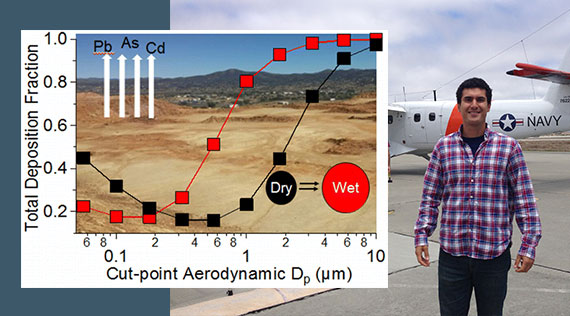Sorooshian Works to Improve Health Assessments of Dust Exposures
A recent UA SRP publication points to the importance of considering particle hygroscopicity in risk assessment. Air pollution has recently been identified as the leading environmental cause of death in the world. In arid environments like Arizona, airborne particulates are especially important due to the prevalence of wind-blown dust. Mining and smelting operations are one contributor to dust in arid regions and in some cases, these dusts are associated with toxic contaminants such as lead and arsenic. Inhalation of dust can result in deposition of particles in the lungs. UA SRP investigator Dr. Armin Sorooshian and his team are working to understand factors that govern particulate deposition in the lung. In particular his group is studying how the humid conditions inside our body affect the size of dry particles that we inhale. Size is important because it in turn affects where, in the respiratory system, a particulate is deposited. Upon inhalation, a dry particle enters the respiratory system which is characterized by high relative humidity. The particle will take up water and begin to grow - the ultimate size of the particle depends on how much water vapor it takes up (a property called hygroscopicity) between our head airways and lungs. When inhaled, a more hygroscopic particle can swell to the point of doubling in diameter as compared to a non-hygroscopic particle. Sorooshian points out that a lack of consideration for hygroscopic growth will lead to incorrect assessments of health effects for toxic particles at known dry sizes.
Sorooshian and his group are performing field measurements and model calculations for particles emitted at the Iron King Mine and Humboldt Smelter Superfund site (Dewey-Humboldt, Arizona) and the Asarco Hayden Plant Superfund site (Hayden, Arizona). Their work is showing that particles enriched with toxic contaminants (e.g., arsenic, lead, cadmium) may vary in their deposition patterns significantly after taking into account their hygroscopic properties. For example, calculations at a relative humidity of 99.5% (representative of the lungs) reveal significant respiratory system particle deposition enhancements (up to 261%) for particles with dry diameters (~320 – 560 nm) which contain the largest concentrations of toxic contaminants at the sites examined.
Publication:
Youn J, Csavina J, Rine K, Shingler T, Taylor MP, Saez AE, Betterton EA, Sorooshian A. 2016. Hygroscopic properties and respiratory system deposition behavior of particulate matter emitted by mining and smelting operations. Environ Sci Technol 50(21):11706–11713. doi:10.1021/acs.est.6b03621.


